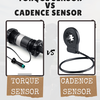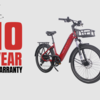Canada eBike Laws

As eBikes become increasingly popular a lot of Canadians find themselves asking the questions, what are the laws for eBikes? What are the requirements for an eBike to be path legal? And what do I need to get started?
We’ll address all that and more in this blog post and hopefully leave you confident to ride your eBike safely and in a way that is compliant with Canadian standards.
What does your eBike need to be legal?
What specs are controlled?
In order to be street legal an eBike must not exceed a 32km/h maximum speed. If the eBike has the capacity to go faster it must be restricted to 32 km/h while on roads in all 10 provinces. That said, many eBikes can go faster than that, but in order to be compliant with the law, it must be ridden on private property.
Likewise across all provinces, an eBike cannot have a motor capacity of more than 500 watts. Similarly to speed requirements when taking a bike off road, you can see much higher powered motors 750 and 1000 watt motors are not uncommon for off road designs.
eBikes do need to function as a bike should. Which is to say it needs to have a fully functioning drive train. Pedals, a crank and chain are all necessary in order to have it recognized as an eBike and not a motor vehicle.
Can I get a throttle?
The previous section might raise a question about getting a throttle on your eBike. The throttle allows the bike to engage the power without pedaling so it might seem as though a throttle could prevent it from being classified as a Pedal Assist Bike (the legal term for an eBike). If that was a concern, rest easy, electric bikes in Canada are allowed to have throttles, so long as the throttle can be switched off and the drivetrain is functional.
Teslica eBikes
All Teslica brand eBikes are constructed to meet Canadian standards and are legal for use on the path and road. That said, modifying the electric bike to go faster, or removing the pedals will turn the eBike into a motor vehicle and it would therefore require license, registration, and insurance.
What do you need to do to make your eBike compliant?
Requirements to Ride
You do not need a license to ride an electric bike in Canada. You do however typically need to meet an age requirement that varies by province. Listed below are the age requirements as they stand May 22, 2024. Legislation on eBikes has changed a fair bit in the past few years with PEI’s requirements changing as recently as 2021. It is always worth making sure you have up to date information on riding laws before you head out onto the roads.
Ages to Ride on Provincial Roads and Paths
|
Ontario |
16+ |
|
Quebec |
14+ |
|
Alberta |
12+ |
|
British Columbia |
16+ |
|
Manitoba |
14+ |
|
New Brunswick |
No age restriction |
|
Newfoundland |
No age restriction |
|
Prince Edward Island |
16+ |
|
Saskatchewan |
16+ |
|
Nova Scotia |
16+ |
How fast can you go on your eBike?
One of the major concerns about eBikes is the speed they are capable of achieving, this has led to Canada setting the legal limit for roads at 32 km/h for eBikes. Saying that, many paths will have their own speed limits that must be respected. Before going for a ride it’s a good idea to look up the path speed limit for the trail you intend to ride on. On many city paths the speed limit will be 20 km/h. As always, obey signage on the path, often speed limits will be posted.
When riding on the road you are free to go up to the bike’s maximum speed of 32 km/h so long as it does not exceed the road limit and it is safe to do so.
How to ride your eBike safely
Safe riding is important for your own health and wellbeing, as well as legally relevant in many cases. Riding an eBike is subject to many of the same safety laws as regular bike riding. Helmets are required for riders under 18 years of age and must be either valid cycling helmets or motorcycle helmets. If you are 18 or older, helmets are not required, but are highly recommended for safe riding.
Signaling your turns to drivers and other riders is also important when on road and path, as is taking care to obey all traffic signs and rules of the road.
eBikes must be kept in decent condition and in working order by law, so having your electric bike looked at regularly by a technician is a good idea for your safety, the longevity of your bike, and in order to be compliant with Canadian standards.
Where can you ride?
eBikes may also be restricted in some areas altogether, check local regulations and path rules for your area. Some paths within parks and natural areas will specify that electric bikes are not allowed. In the Ottawa region, Gatineau Park prohibits entirely power assisted bikes on their pathways.
As with regular pedal bikes, 400 series highways and some major roads restrict access to all bicycles and eBikes are no exception. Signage will likely be posted to indicate where these areas are, but as a general rule if you can’t ride a regular bike on the road, you also can’t ride an eBike there either.
Respect local regulation and signage if you see an indication that the roads aren’t for eBikes. Most paths however, will allow eBikes as long as they obey posted speed limits.





